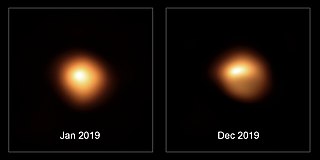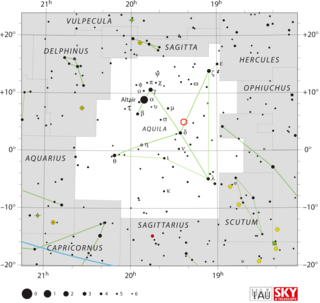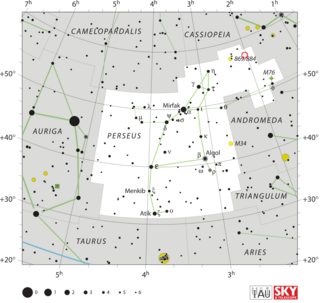
A variable star is a star whose brightness as seen from Earth changes with time. This variation may be caused by a change in emitted light or by something partly blocking the light, so variable stars are classified as either:

In astronomy, cataclysmic variable stars (CVs) are stars which irregularly increase in brightness by a large factor, then drop back down to a quiescent state. They were initially called novae, since ones with an outburst brightness visible to the naked eye and an invisible quiescent brightness appeared as new stars in the sky.

V1500 Cygni or Nova Cygni 1975 was a bright nova occurring in 1975 in the constellation Cygnus. It had the second highest intrinsic brightness of any nova of the 20th century, exceeded only by CP Puppis in 1942.

V1494 Aquilae or Nova Aquilae 1999 b was a nova which occurred during 1999 in the constellation Aquila and reached a brightness of magnitude 3.9 on 2 December 1999. making it easily visible to the naked eye. The nova was discovered with 14×100 binoculars by Alfredo Pereira of Cabo da Roca, Portugal at 18:50 UT on 1 December 1999, when it had a visual magnitude of 6.0.

In astronomy, an intermediate polar is a type of cataclysmic variable, binary star system with a white dwarf and a cool main-sequence secondary star. In most cataclysmic variables, matter from the companion star is gravitationally stripped by the compact star and forms an accretion disk around it. In intermediate polar systems, the same general scenario applies except that the inner disk is disrupted by the magnetic field of the white dwarf.

A dwarf nova, or U Geminorum variable, is one of several types of cataclysmic variable star, consisting of a close binary star system in which one of the components is a white dwarf that accretes matter from its companion. Dwarf novae are dimmer and repeat more frequently than "classical" novae.

AM Herculis is a binary variable star located in the constellation Hercules. This star, along with the star AN Ursae Majoris, is the prototype for a category of cataclysmic variable stars called polars, or AM Her type stars.
An AM Canum Venaticorum star, is a rare type of cataclysmic variable star named after their type star, AM Canum Venaticorum. In these hot blue binary variables, a white dwarf accretes hydrogen-poor matter from a compact companion star.
A luminous supersoft X-ray source is an astronomical source that emits only low energy X-rays. Soft X-rays have energies in the 0.09 to 2.5 keV range, whereas hard X-rays are in the 1–20 keV range. SSSs emit few or no photons with energies above 1 keV, and most have effective temperature below 100 eV. This means that the radiation they emit is highly ionizing and is readily absorbed by the interstellar medium. Most SSSs within our own galaxy are hidden by interstellar absorption in the galactic disk. They are readily evident in external galaxies, with ~10 found in the Magellanic Clouds and at least 15 seen in M31.

CE Gruis is a faint binary star system in the constellation Grus. It is a variable star, with a B-band brightness that ranges from a peak magnitude of 17.4 down to a minimum of 19.5 over a period of 108.6 minutes. The system is composed of a white dwarf and donor star, locked into a close, synchronous orbit. In such systems, known as polars, material from the donor star does not form an accretion disc around the white dwarf because of its intense magnetic field, but rather streams directly onto it along columns.

QS Telescopii is a faint, well-studied binary star system in the southern constellation Telescopium. It is composed of a white dwarf and main sequence donor star, locked into a close, circular orbit facing one another. Known as polars, material from the donor star does not form an accretion disk around the white dwarf, but rather streams directly onto it. This is due to the presence of the white dwarf's strong magnetic field. The pair undergo frequent shifts between a high and low accretion states, and it shifts between single and double accretion poles. The main pole is partially self-eclipsing.
SW Sextantis variable stars are a kind of cataclysmic variable star; they are double-star systems in which there is mass transfer from a red dwarf to a white dwarf forming a stable accretion disc around the latter. Unlike other non-magnetic cataclysmic variables, the emission lines from hydrogen and helium are not doubled, except briefly near phase 0.5.

PX Andromedae is an eclipsing cataclysmic variable star in the constellation Andromeda. It has been classified as a SW Sextantis variable, and its apparent visual magnitude varies between 14.04 and 17.

V455 Andromedae is a dwarf nova in the constellation Andromeda. It has a typical apparent visual magnitude of 16.5, but reached a magnitude of 8.5 during the only observed outburst.

V1315 Aquilae is a cataclysmic variable star in the north of the equatorial constellation of Aquila. It is in the sub-set of nova-like (NL) variables, specifically a SW Sextantis star. These were characterized as having non-magnetic white dwarfs – thus that do not undergo dwarf-nova bright luminations ("eruptions"). There is countering evidence for some magnetism. Being a SW Sextantis star, V1315 Aquilae has a high rate of mass transfer, so it is in steady-state accretion and in a constant state of outburst. It emits most of its light in the visible range, and this comes from the accretion disk. The eclipse depth is 1.8 mag. No description of the donor star is made.

UZ Fornacis is a binary star in the constellation of Fornax. It appears exceedingly faint with a maximum apparent magnitude 17.0. Its distance, as measured by Gaia using the parallax method, is about 780 light-years.

V Persei, also known as Nova Persei 1887 was discovered by Williamina Fleming on a Harvard College Observatory objective-prism photograph taken on 3 November 1887. It is believed to be the first nova whose spectrum was recorded. The nova had an apparent magnitude of 9.2 at the time of discovery. Judging from the consistency of the nova's brightness after discovery, and details of the spectral lines seen, McLaughlin estimated that the nova was five or six months past peak brightness at the time of its discovery, and at its peak it was almost certainly at least as bright as 4th magnitude. So V Persei was probably visible to the naked eye, though there is no record that anyone actually noticed it when that was possible. It is currently an 18th magnitude object.

BG Canis Minoris is a binary star system in the equatorial constellation of Canis Minor, abbreviated BG CMi. With an apparent visual magnitude that fluctuates around 14.5, it is much too faint to be visible to the naked eye. Parallax measurements provide a distance estimate of approximately 2,910 light years from the Sun.

QQ Vulpeculae is a cataclysmic variable binary star system in the northern constellation of Vulpecula, abbreviated QQ Vul. It has a brightness that fluctuates around an apparent visual magnitude of 14.7, which is too faint to be viewed with the naked eye. The distance to this system is approximately 981 light years based on parallax measurements.

YY Draconis and DO Draconis are separate identifiers for what is likely the same cataclysmic variable system in the northern constellation of Draco, abbreviated YY Dra and DO Dra, respectively. The DO Dra binary star system is classified as a U Geminorum variable that ranges in luminosity from an apparent visual magnitude of 10.0 down to 15.1. It is located at a distance of approximately 639 light years from the Sun.

















